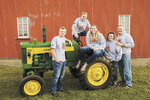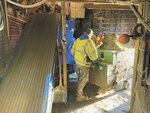

ALBANY, Minn. — Every year, Luke Herkenhoff and his family are faced with a recurring issue. Their silo that stores the farm’s silage freezes, causing extra work for the family.
“Every year we run into this trouble,” Herkenhoff said. “We look for more preventive measures, because if you run the silo through the cold, it seems like something always breaks that costs more than just feeding out of the silage bag. Plus, it’s never fun to be up there in the cold.”
Herkenhoff farms with his two sons, Tony and Sam, and his parents, Duane and Linda, who help on the farm. Together, they milk 44 cows in tie stalls and crop 220 tillable acres to grow corn, alfalfa and small grains.
This year, the silage froze during the cold weather around Jan. 21. The silo was out of commission for about a week, which is normal for every time it freezes over.
“We quit feeding out of the silo and fed out of the bag,” Herkenhoff said. “It’s a lot more labor intensive. Sometimes I will push the unloader, and other years, I’ll say we just have to quit using the silo.”
Since all feed for the milking cows is run through a mixer, they take silage from the bag — after picking through it and taking the less frozen silage — and then dump it into the side door of their barn. After the silage is in the barn, they use a wheelbarrow to move it to the conveyer which then dumps it in the mixer.
This process adds an extra hour to both morning and evening chores versus a functioning silo.
However, not all news is bad when the silo freezes. The cows never seem to mind the switch. At times, Herkenhoff said it seems beneficial to feed out of the bag because they can pick out more of the ice chunks that negatively affect the quality of the ration.
“It’s the same corn silage, so it doesn’t affect the cows, so that’s a good thing,” Herkenhoff said. “We usually chop everything at the same time; otherwise, it would have disrupted the rations. Also, the mixer is able to break up some of the chunks of ice, but we still try to break it up and sort through it when we can.”
This year, Herkenhoff had his 20- by 90-foot silo half gone when the silage froze, and they switched to the bag. Another perk is that they do not have to struggle to get a frozen bag open when the silo freezes since they feed silage out of the bag to youngstock.
After the cold weather, it normally takes two days of warmer weather before they can run the silo again. Before starting the silo, Herkenhoff checks the unloader to ensure it will not become damaged when it is turned on.
“This year has been easy to deal with (the silo) because of the warmer weather,” Herkenhoff said.
After the weather warms for a couple of days and the unloader has been safely checked to ensure it is not frozen, Herkenhoff can turn on the unloader and resume use.
“I have learned to just look to prevent anything from breaking and not pushing the unloader,” Herkenhoff said. “Plus, hauling the silage is a good way to warm up if you’re cold.”
Comments
No comments on this item Please log in to comment by clicking here